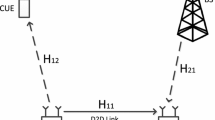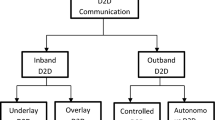Abstract
With the implementation of device-to-device (D2D) communication in primary cellular networks, there will be notable benefits such as increase in cellular capacity, energy efficiency and spectral efficiency. The interference to the cellular user equipment (CUE), due to D2D pairs is reduced with proper strategies on resource allocation and transmit power assignment to the D2D pairs. This leads to healthier sum rate and battery life of D2D pairs. In this paper, we propose a distance-based interference reduction and power management scheme to reduce the interference on CUEs and evolved NodeB (eNB) and thus improve the sum rate of D2D pairs. The power allocation is based on the D2D pairs distance to the CUEs and eNB, which is estimated based on Haversine formula. The transmit power of D2D transmitter is effectively manipulated with respect to the transmit power of CUEs. The system sum rate, total transmit power of D2D pairs and the battery life of D2D user equipment are analyzed and validated through simulation.








Similar content being viewed by others
References
Gandotra, P., & Jha, R. K. (2016). Device to device communicaton in cellular netwroks: A survey. Journal of Networks and Computer Applications,71, 99–117.
Noura, M., & Nordin, R. (2016). A survey on interference management for device-to-device (d2d) communication and its challenges in 5 g networks. Journal of Net- works and Computer Applicationsm,71, 130–150.
Asadi, A., Wang, Q., & Mancuso, V. (2014). A survey on device-to-device communication in cellular networks. IEEE Communications Surveys and Tutorials,16(4), 1801–1819.
Feng, D., Lu, L., Yuan-Wu, Y., Li, G., Li, S., & Feng, G. (2014). Device-to-device communications in cellular networks. IEEE Communications Magazine,52, 49–55.
Noor Mohammed, V., Jere, S., & Kaushikbhai, V. S. (2015). Resource allocation for wireless network environment. In 2015 international conference on soft computing systems: Advances in intelligent systems and computing (pp. 501–508).
Zhao, W., & Wang, S. (2015). Resource sharing scheme for device-to-device communication underlaying cellular networks. IEEE Transactions on Communications,63(12), 4838–4848.
Ye, Q., Al-Shalash, M., Caramanis, C., & Andrews, J. G. (2015). Distributed resource allocation in device-to-device enhanced cellular networks. IEEE Transaction on Communications,63(2), 441–454.
Xu, C., Song, L., Han, Z., Zhao, Q., Wang, X., Cheng, X., et al. (2013). Efficiency resource allocation for device-to-device underlay communication systems: A reverse iterative combinatorial auction based approach. IEEE Journal on Selected Areas in Communications,31(9), 348–358.
Duong, Q., Shin, Y., & Shin, O.-S. (2015). Distance-based resource allocation scheme for device-to-device communications underlaying cellular networks. AEU- International Journal of Electronics and Communications,69(10), 1437–1444.
Rajkumar, N., Lakshmanan, M., Mohammed, V. N., & Palanivelan, M. (2017). Distance based uplink resource sharing for device-to-device communication. In 2017 4th international conference on electronics and communication systems (ICECS) (pp. 74–77). IEEE.
Wang, F., Song, L., Han, Z., Zhao, Q., & Wang, X. (2013). Joint scheduling and resource allocation for device-to-device underlay communication. In Wireless communications and networking conference (WCNC) (pp. 134–139). IEEE.
Wang, F., Xu, C., Song, L., & Han, Z. (2015). Energy-efficient resource allocation for deice-to-device underlay communication. IEEE Transactions on Wireless Communications,14(4), 2082–2092.
Yang, Z., Huang, N., Xu, H., Pan, Y., Li, Y., & Chen, M. (2016). Downlink resource allocation and power control for device-to-device communication underlaying cellular networks. IEEE Communications Letters,20(7), 1449–1452.
Yu, G., Xu, L., Feng, D., Yin, R., Li, G. Y., & Jiang, Y. (2014). Joint mode selection and resource allocation for device-to-device communications. IEEE Transactions on Communications,62(11), 3814–3824.
Belleschi, M., Fodor, G., & Abrardo, A. (2011). Performance analysis of a distributed resource allocation scheme for d2d communications. In GLOBECOM Workshops (GC Workshops) (pp. 358–362). IEEE.
Zhang, H., Song, L., & Han, Z. (2016). Radio resource allocation for device-to-device underlay communication using hypergraph theory. IEEE Transactions on Wireless Communications,15(7), 4852–4861.
Aparna, M., Debasamita, B., Noor Mohammed, V., Lakshmanan, M., & Palanivelan, M. (2017). Optimum allocation of resources of d2d communication. In Information embedded and communication systems (ICIIECS-2017) (pp. 1–4). IEEE.
Robusto, C. (1957). The cosine-haversine formula. The American Mathematical Monthly,64(1), 38–40.
Winarno, E., Hadikurniawati, W., & Rosso, R. N. (2017). Location based service for presence system using haversine method. In International conference on innovative and creative information technology (ICITech) (pp. 1–4).
GPP TR 36.814V9.0.0(2010-03). (2010). 3rd Generation partnership project; technical specification group radio access network; evolved universal terrestrial radio access (E-UTRA); further advancements for E-UTRA physical layer aspects(Release 9).
Khalily-Dermany, M. (2017). A convex programming for range assignment to optimize lifetime in network-coding-based-wireless-sensor networks. International Journal of Wireless Information Networks,24(4), 470.
Zulhasnine, M., Huang, C., & Srinivasan, A. (2010). Efficient resource allocation for device-to-device communication underlaying lte network. In 2010 IEEE 6th international conference wireless and mobile computing, networking and communications (WiMob) (pp. 368–375).
Author information
Authors and Affiliations
Corresponding author
Additional information
Publisher's Note
Springer Nature remains neutral with regard to jurisdictional claims in published maps and institutional affiliations.
Rights and permissions
About this article
Cite this article
Mohamad, N.M.V., Nagarajan, R., Muthukaruppan, L. et al. Uplink Resource Sharing and Power Management Scheme for an Underlay D2D Communication. Wireless Pers Commun 110, 637–650 (2020). https://doi.org/10.1007/s11277-019-06747-7
Published:
Issue Date:
DOI: https://doi.org/10.1007/s11277-019-06747-7




